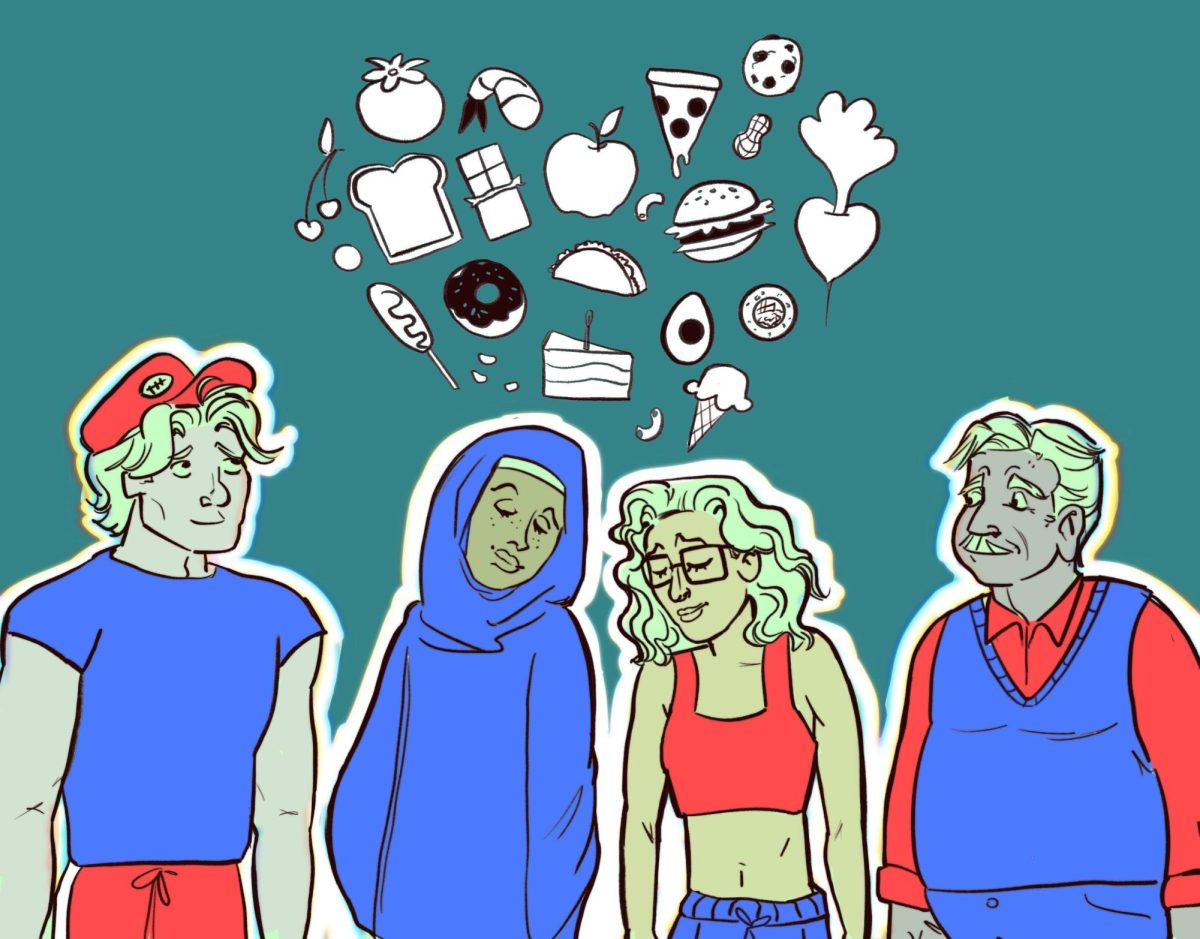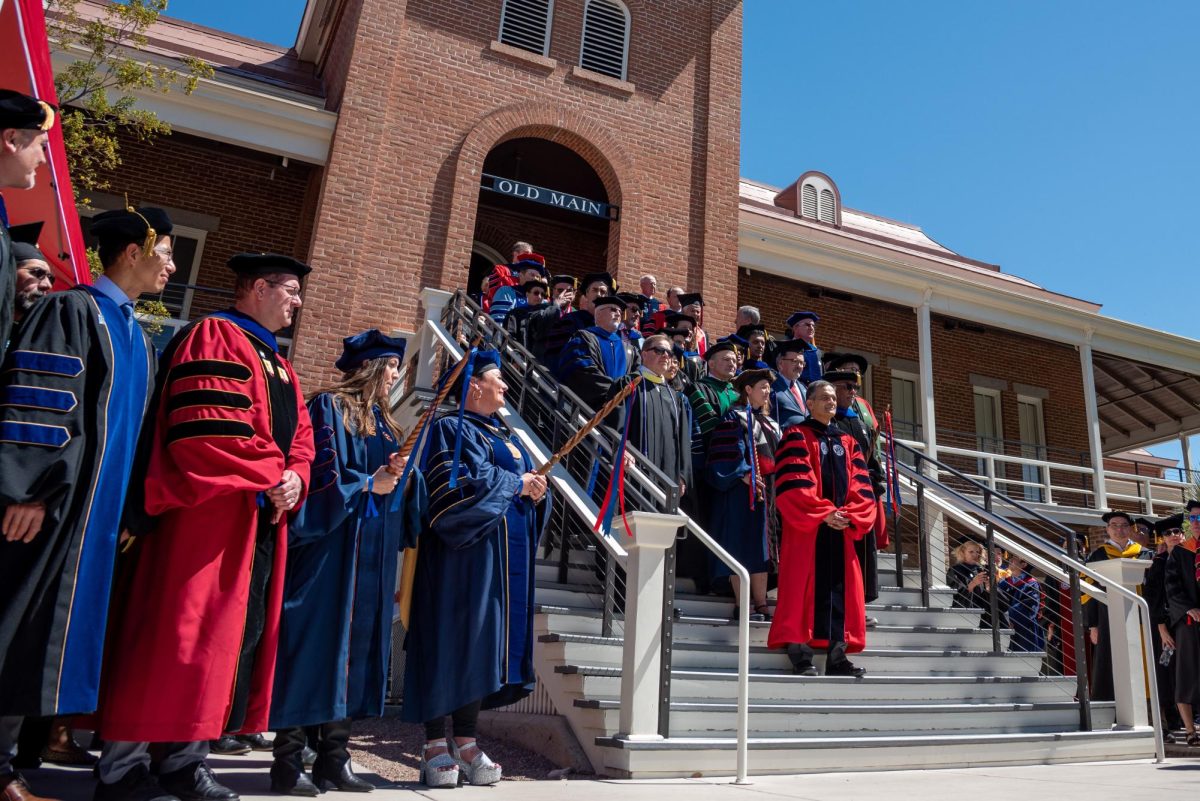Eating disorders are among the many illnesses that are not easily identifiable, making it difficult to recognize who may be struggling and require support. They are complex mental health illnesses which alter an individual’s relationship with food, affecting the way one thinks of food and their eating behaviors, among other effects.
Misrepresentation and stigma play a large role in how eating disorders are perceived. Societal representations of eating disorders often include sensationalized visuals of extremely emancipated individuals; however, that is simply not the reality of the illnesses.
There are many types of eating disorders beyond the stereotypical portrayal of anorexia, and binge eating is the most common in the United States.
Such drastic portrayals of the most common emotional and physical representation of the illness further complicate the ability of individuals to identify a disorder and seek help.
According to University of Arizona health education and promotion manager Lisa Anne MacDonald, “eating disorders show up in all ages, all body sizes, all sexual orientations, all racial backgrounds, all of that. It’s not illness that discriminates. Which is also a misconception because I think historically people thought of it as a women’s disease and as a white women’s disease.”
According to the National Eating Disorders Association, risk factors for eating disorders can be broken down into three categories: biological, social and psychological.
Biological risk factors include having close friends or family which increases personal risk; low energy availability, where the body lacks energy to support all its needs (commonly found in athletes with high energy need); and Type 1 diabetes, which is linked to higher risk of eating disorders.
Social ideas like thinner is better and the various health trends on social media cause individuals to buy into false narratives of what an ideal body looks like, increasing the likelihood that they will take part in dieting and food restrictions.
One of the strongest risk factors for an eating disorder is perfectionism, which falls under the psychological category as established by NEDA. In just one example of the role of perfectionism in eating disorder development, the idea of eating a perfect meal with unrealistic expectations can lead to food avoidance altogether.
This category of mental illness also has many social drivers that may enable its progression, such as financial insecurity, lack of access to grocery stores and increased media consumption.
These challenges are especially common among college students who often face significant lifestyle changes after leaving home. The transition to independent living coupled with increased responsibilities can be overwhelming and can result in cementing harmful lifestyle choices.
“So for many, it’s the first time in their lives that they’ve ever had to take on the responsibility of feeding themselves. And not only is that a new thing, but now you are in this new environment where it’s not necessarily the foods you’re accustomed to having and then balancing the rigors of academic life with social life, like figuring that all out and figuring out how we are going to feed ourselves in the context of all of that,” MacDonald said. “And I think too, for a lot of our students, especially high achieving students, there’s a characteristic of some perfectionism.”
Such changes in one’s lifestyle can result in a phenomenon known as disordered eating, which is different from an eating disorder. Individuals with disordered eating often exhibit behaviors of dieting, skipping meals, restricting food intake and excessive exercising but do not meet the frequency or psychological criteria for a diagnosable eating disorder.
According to MacDonald, this is something many university students experience.
“A really great example of that is we see a lot of our students presenting with what we call orthorexia, which is not a fully recognized eating disorder, but it is like disordered eating is bridging an eating disorder. It’s essentially striving for the perfect diet,” MacDonald said. “And I do think social media and interactions are influencing this in a really big way, the morality around food. This is good. This is bad. This is poison. This is clean. A lot of that language puts us in this very moral space around food and elitism around food. And that’s a very fine line in that eating disorder versus disordered eating space,” MacDonald said.
The 2024 Health and Wellness Survey Data at the UA revealed that 31% of students suffer from disordered eating, 35% of students feel the negative effects of being hyper focused on body image, food or weight and 61% of students report that their weight affects their self-perception.
“There are very specific diagnostic criteria for eating disorders, which are often based on the frequency and intensity of the eating behavior. The thoughts and beliefs that exist around food and body and what the body should look like. We find that all of our students don’t fit the criteria for the very specific eating disorder but are dappling in the behaviors, dappling in the thought process, so maybe not fully diagnosable but the thoughts and the behaviors are there,” MacDonald said.
Counseling and Psych Services and Campus Health at the UA provide many services to help students who may be struggling with eating disorders or disordered eating.
Each student has different needs and demands multiple lenses to create solutions. The Eating Disorder Assessment Team at the UA takes a multidisciplinary approach to these solutions, which includes medical providers, psychiatrists, counselors and dieticians on the team who work together to support students through recovery.
The counseling and psychiatry appointments with eating disorder specialists focus on the context of the eating disorder in one’s life, how to establish coping skills and create a sustainability plan.
Individual consultations on nutrition and fitness with registered dietitians focus on discussing food options on campus, how to build better eating habits and tailoring food recommendations to individual needs.
“A lot of our work has to do with meeting folks where they are. So we’re going to spend a good 90 minutes at our first appointments with students, really investigating all kinds of health behaviors, really talking about what the goals are and then working with the student to find how they can fuel themselves well under all of those circumstances. I will say a common way I go about this is talking about stabilizing the nutrition,” MacDonald said. “And so that does begin with the conversation about, can we get into more consistent eating patterns? Can we keep those eating patterns pretty well balanced and see how that affects how we’re functioning in our lives and how it feels to have a fueled brain when you’re in class and studying? So working on that stabilization,” MacDonald said.
This stabilization process begins with helping students avoid gravitating towards branded foods and focus on other options for food available on campus. MacDonald explains how many students walk into the Student Union and gravitate towards stores like Chick-fil-A and Panda Express without also realizing that in between other stores there is an IQ Fresh, Radicchio, Urban Market and Core with healthier options.
However finding solutions is not as simple as it seems. An eating disorder is not a choice, but a complex mental health condition.
“There’s so many layers and we have all been socialized to want to lose weight. Like we don’t even think about it, and we think we should want to lose weight,” Leslie Ralph, a psychologist at the UA, said.“ And so there’s this hustle culture. There’s just the university environment and the flow of the stress that you all go through. And there’s this kind of mindset that I notice with students that, like, not actively trying to lose weight, but I also don’t mind if I’m losing weight.”
The development of an eating disorder can be influenced by a variety of other factors beyond the desire to lose weight, like anxiety, depression or PTSD.
“People don’t always come into an eating disorder intentionally thinking about losing weight, but because they’re anxious, they might notice they have stomach discomfort. There’s a lot of research on the role of trauma and how that impacts our nervous system and how that feeds into eating disorders. There’s a lot of layers. When we are in that malnourished state, it does impact the way our brain functions and it can make anxiety worse or depression worse,” Ralph said.
“Eating disorders are very often related to depression, anxiety, OCD, and ADHD. And so the eating behaviors, the beliefs, end up being coping mechanisms for students, and they end up being maladaptive coping mechanisms,” MacDonald said. “You’ll hear a lot of folks say, it’s the only thing I feel like I have any control over. So if we’re in a place in our life where we’re not feeling any control, for example, the pandemic was not great for eating disorders. I think a lot of things went on there, everything from feeling like we’re not not in control, to food scarcity to the social media impact.”
Loneliness can often be a large aspect or contributing factor to eating disorders, so community becomes an important part of interventions.
Food and Mood is a support group offered by CAPS that meets every Tuesday 3:30-4:30 pm over Zoom (password: 046281). The group builds hope for breaking cycles of disordered eating, explores what it means to be healthy and provides a place to talk about how you feel about food and your body in a safe and supportive environment. The support group meetings are facilitated by MacDonald and Jan Courtney, a nutrition counselor at the UA.
EveryBODY Arizona is another resource provided through Campus Health. The group is primarily a student-led initiative that encourages students to come from a more weight-neutral and food-neutral place, providing educational opportunities and outreach events focused on forming a healthy relationship with food and body.
The UA also offers Cooking on Campus classes at $10 per session where students are taught how to make two dishes. The next class is on March 25, during which students will learn how to make chickpea and spinach curry with homemade naan in Shantz 101.
Eating disorders, like many other mental illnesses, demand support. It is important to reflect on our own relationship with food, begin conversations with our friends, utilize the free on campus resource and discuss with healthcare professionals.









